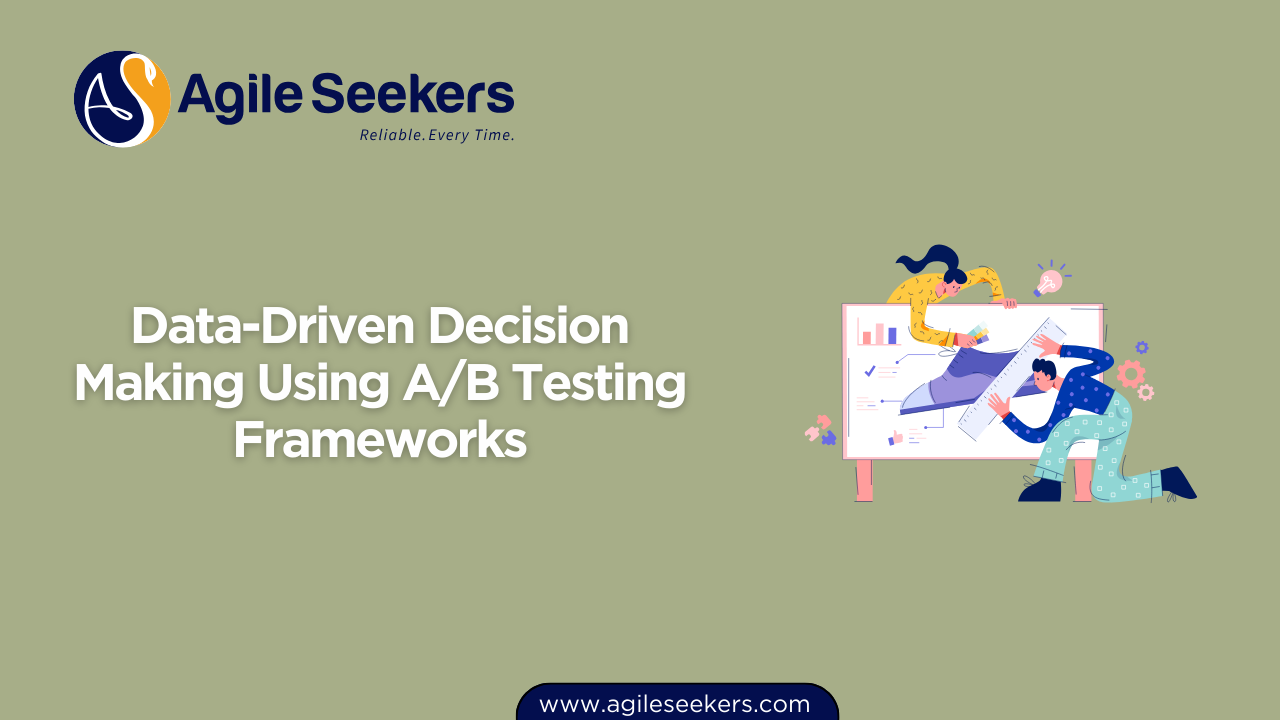Data-Driven Decision Making Using A/B Testing Frameworks

Every product team eventually faces critical decisions—what design works best, which feature should be prioritized, or which call-to-action gets more conversions. While opinions are valuable, data provides clarity. That’s where A/B testing frameworks come into play. These structured, controlled experiments help teams test hypotheses, validate assumptions, and make informed decisions backed by user behavior.
What Is A/B Testing?
A/B testing is a statistical method that compares two versions of a variable—like a webpage, product feature, or email subject line—to determine which performs better. Version A is typically the control, while version B introduces a change. By directing a portion of users to each version and measuring outcomes like click-through rates, bounce rates, or conversions, teams can determine which approach drives better results.
This testing method is foundational in optimizing user experiences, especially when rolled out at scale. It's also a critical practice for Product Owners and Product Managers who must justify prioritization choices based on evidence, not intuition.
Why A/B Testing Matters in Data-Driven Decision Making
Data-driven decision-making minimizes risk and enhances confidence in product strategy. A/B testing frameworks help product teams do the following:
- Quantify impact: Know exactly how a change affects user behavior.
- Reduce guesswork: Move from assumptions to validated insights.
- Speed up iteration: Make small, incremental changes with measurable outcomes.
- Optimize for business goals: Drive metrics that matter—signups, sales, or retention.
For professionals preparing for roles in product management, especially those undergoing SAFe POPM Certification, understanding A/B testing is crucial for validating hypotheses and aligning product features with customer value.
Key Components of an A/B Testing Framework
A solid A/B testing framework includes these elements:
- Hypothesis: A clear, testable statement. Example: “Changing the color of the CTA button will increase sign-ups.”
- Segmentation: Define user segments—new users, returning users, mobile users, etc.
- Metrics: Determine what success looks like. Clicks, time on page, or completed checkouts?
- Traffic allocation: Decide how many users see each variant.
- Duration: Ensure the test runs long enough to reach statistical significance.
Project Managers with PMP Certification often apply similar structures when running project pilots or phase-wise rollouts, making A/B testing an adjacent skill to structured decision-making under uncertainty.
Running Effective A/B Tests
Simply running a test isn’t enough. It must be designed well to produce valid and actionable insights. Here are best practices:
1. Test One Variable at a Time
If you change multiple elements (e.g., button color, headline, layout), you won’t know what drove the impact. Isolate your variables.
2. Avoid Sample Bias
Make sure your test groups are randomly selected and large enough to represent your audience. A skewed sample could lead to misleading conclusions.
3. Wait for Statistical Significance
Don’t rush to conclusions. Use a statistical calculator to ensure your results are not due to chance. Tools like Optimizely’s calculator or AB Test Guide help verify significance.
4. Document Everything
Keep a test log. Record the hypothesis, variations, date ranges, results, and next steps. This builds organizational knowledge over time and avoids duplicate testing.
Common Mistakes to Avoid
- Stopping the test too early: This leads to inconclusive or false results.
- Testing without a clear hypothesis: Random tests rarely provide value.
- Ignoring small gains: A 1% increase in conversion can mean massive gains over time, especially in high-traffic products.
- Failing to segment results: Sometimes improvements only apply to certain user segments. Ignoring this limits your understanding.
Examples of A/B Testing in Product Management
Here are real-world use cases where A/B testing has impacted decision-making:
- SaaS Platforms: Testing different onboarding flows to reduce churn.
- E-commerce: Comparing product descriptions to boost conversions.
- Mobile Apps: Experimenting with push notification timings to increase engagement.
Professionals undergoing SAFe Product Owner Certification learn how to integrate such insights into Program Increment (PI) planning and backlog prioritization. Data-backed decisions help drive better alignment with business and customer needs.
When Not to Use A/B Testing
Despite its benefits, A/B testing is not always the right tool:
- Low traffic environments: Tests may take too long to yield results.
- Major UI overhauls: Multivariate or qualitative testing might be more useful.
- Critical features: Features tied to compliance or data integrity shouldn’t be tested on live users.
Integrating A/B Testing Into Agile Frameworks
Teams practicing Agile can incorporate A/B testing as part of their validation cycle. For instance, a Scrum team can tie an experiment to a sprint goal. In SAFe environments, Product Managers often use A/B test data to inform capabilities or features in the Program Backlog. This aligns with what’s taught in SAFe POPM training, where continuous learning is part of the Lean-Agile mindset.
Similarly, professionals pursuing PMP training can use A/B testing as a risk mitigation tool. Instead of committing fully to a change, they can validate on a small scale and then roll out broadly.
Final Thoughts
A/B testing is more than just comparing colors or button sizes—it’s a systematic approach to validating product decisions. When done right, it empowers teams to ship with confidence, improve user experience, and drive business outcomes.
Whether you're a Product Manager seeking structured experimentation or a Project Manager applying controlled tests before scaling changes, understanding A/B testing will strengthen your decision-making skills. It’s also a vital component of effective product ownership, as emphasized throughout SAFe Product Owner/Manager certification.
For a deeper grasp of structured frameworks, experimentation techniques, and customer-centric planning, explore Project Management Professional certification programs that emphasize data-driven governance and predictive analysis.
Also read - Designing Feature Flags for Controlled Product Rollouts




















